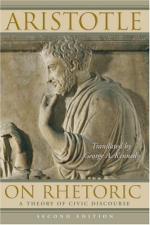
|
| Name: _________________________ | Period: ___________________ |
This quiz consists of 5 multiple choice and 5 short answer questions through Book III, Chapters 1-9.
Multiple Choice Questions
1. In Aristotle's opinion, why were many people not swayed by sound arguments?
(a) They were too uneducated.
(b) They were not emotional enough.
(c) They were too emotional.
(d) They were too educated.
2. What shape was described in the example Aristotle provided for the use of description in an impressive speech?
(a) Triangle.
(b) Rectangle.
(c) Square.
(d) Circle.
3. What did Aristotle think a high value of life in older people led to?
(a) Selfishness.
(b) Skepticism.
(c) Thoughtfulness.
(d) Appreciation.
4. According to Aristotle, how did people in their prime view success?
(a) It was not improbable.
(b) It was probable.
(c) It was not possible.
(d) It was not impossible.
5. What did Aristotle think the structure of a sentence should always be?
(a) Clear.
(b) Detailed.
(c) Simple.
(d) Implied.
Short Answer Questions
1. How many non-technical means of persuasion did Aristotle discuss in Book I, Chapter 15?
2. What did the paean avoid in order to gain Aristotle's endorsement as the ideal rhythm for prose?
3. What did Aristotle think was the intent of all voluntary actions?
4. What did Aristotle think orators should be careful of when writing their speeches?
5. Why did Aristotle think the universal law was higher than the special law?
|
This section contains 257 words (approx. 1 page at 300 words per page) |

|




